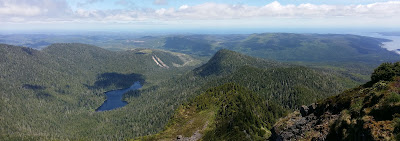Day 2 of the Chilkoot Trail is a cool day with good visibility and amazing views:
Mike: “If I lived in Whitehorse, I would hike this trail every year”.
Day 3 of the Chilkoot Trail is rainy and foggy. We had to climb up “the golden stairs” in the thick fog that made the rocks we were climbing wet and slippery and then had to “hike” on snow in the downpouring rain.
Kim: “This is ridiculous. I can’t believe people hike this trail”.
Don’t worry
though. Day 3 on the Chilkoot Trail was more like type 2 fun (not
necessarily fun while you are doing it but fun to talk about
afterward). The Chilkoot trail has definitely been one of the
highlights of our trip so far.
Let me start at the
beginning though. For those unfamiliar with the Chilkoot trail (as I
was before hiking it), it is a historic trail that starts in Skagway,
Alaska (or technically Dyea, Alaska) and ends in Bennett Lake, BC.
It is managed by the National Park Service on the US side and Parks
Canada on the Canadian side. The “summit” is the border crossing
(and where toilet paper is no longer available in the outhouses –
more on this later).
The trail is made
famous as it roughly follows the route the “Stampeders” took back
in 1897-98 in their quest for gold in the Yukon (or more specifically
Dawson City). Who are these Stampeders? They were people from all
of over North America who heard about gold, took a train west from
wherever they were from, took a boat from Seattle (or Vancouver) to
Skagway, had to buy a ton of goods (or the Canadian Police would not
let them cross the border), haul it by horse or dog sled or tram or
by their own strong back along the trail in the middle of winter,
climb the golden stair case multiple times, build a boat (I don’t
think any of them were boat builders) that could navigate the Yukon
River to eventually bring them to Dawson City and gold.
Unfortunately by the time they got there (if they survived the harsh
conditions, avalanches and rapids that resembled “white horses”),
there were no more land claims to be had so ultimately – no gold for them. I
think one of the hikers from this year put it best in the guest book when she said “The Stampeders would be
pissed to know that 3000 people/year now hike this trail for fun”).
The hike is truly
historic though. There is still remnants of the trams, the “stuff”
people left on the trail because it was too heavy to carry, the
interpretive signage throughout as well as a historic talk at one of
the campsites by a ranger. The scenery is also amazing – you start
in coastal rainforest, climb up into the alpine and tundra and then
end in the boreal forest. And the golden stairs? I guess it is the
part of the trail you will always remember but it really is sketchy
doing it in the rain. You are literally climbing up rocks using
hands and feet. It is not rock climbing per se (that would have been
type 3 fun) but it is also not a steep “hike” anymore. When
the Stampeders did it, it was winter so they carved stairs into the
ice (hence the name “golden staircase”).
What also made this
trail unique to Mike and I was the social aspect. Our multi day
backpacking hikes have previously been on trails that don’t get
hiked nearly as much as the Chilkoot (ie Mantario Trail (on the
border of Manitoba and Ontario), Cape Chignecto (in Nova Scotia) and
Pukwasqua National Park (near Marathon Ontario). We would maybe see
one other group out hiking these trails the entire time we were
hiking (which was normally 3-5 days). On the Chilkoot though, there
are approximiately 35-50 getting on the trail daily. And because you
tended to stay at the same campsites sharing picnic tables or were
hiking with them, you got to know those other hikers. After doing the summit in
the pouring rain and sharing a warming hut that is the size of our
van, you really got to know people quite well! And everyone was
lovely. Each with their own story of where they were from, why they
were hiking the trail and where they were going next. So thank you
to our fellow hikers from North Bay, Barrie, Canmore, Logan Lake,
Holland as well as the boy scout group from Fairbanks. What a great
experience to have shared with all of you.
And finally the
toilet paper issue. Don’t get me wrong, both the National Park
Service and Parks Canada does great work keeping this trail clear of fallen trees and well marked. There are lovely campsites with pit toilets,
picnic tables, tent platforms, covered shelters and warming huts
along the way. It is just interesting hiking a trail that has half
the trail and campsites on the US side and half on the Canadian side.
There are a few differences in what to do with grey water but the
other difference is the National Park Service (US) supplies toilet paper in the outhouses and
Parks Canada does not. Which is not a big deal unless you have just
arrived at the summit in the pouring rain and you need to pee. When
you get in the outhouse and sit down –
Kim: “shoot – I am in Canada now”.























